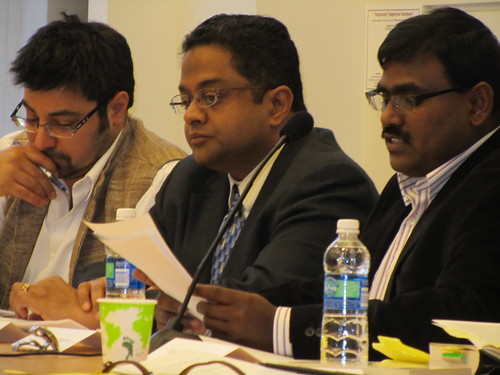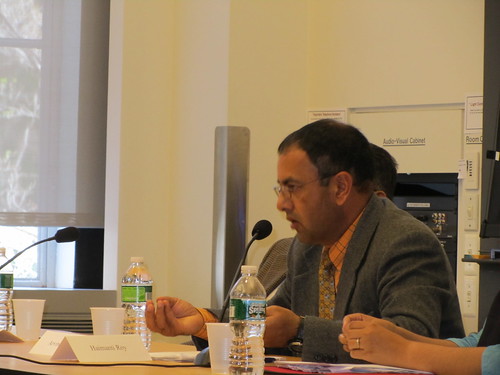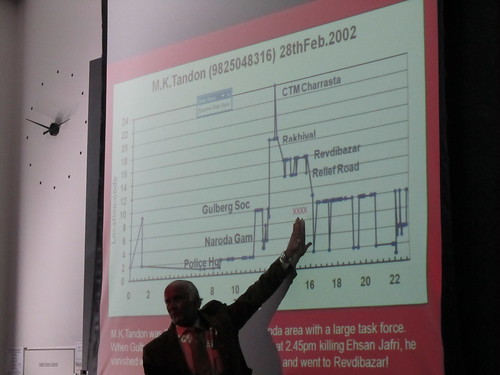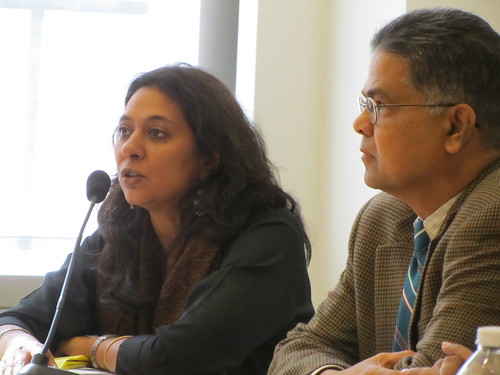By Kashif-ul-Huda, TwoCircles.net,
What are the threats to secularism and the rule of law in India? Some of the best minds of academia, activism, media, and administration came together to discuss various challenges to India at the two-day workshop organized at Massachusetts Institute of Technology (MIT) in Cambridge.
Program opened on Friday April 9th by a keynote speaker by Professor Paul R. Brass. Prof. Brass research on India expands four decades. He examined in details the anatomy of communal riots. Communal riots unfolds in three stages with pre and post riots stages as important as what happens during the actual violence. Each of these stages have various actors that seek to gain from this violence. Almost all group violence are means to a political end. Prof. Brass opined that all district magistrates have the capability of stopping the violence if they so wished.

Day two was packed with five sessions that looked closely the meaning of secularism in Indian context, conduct of state agencies during violence, assessing police performance in countering violence, challenges in justice, and media reporting of terrorism.
Session 1: Secularism and the State: Changing Contours

L to R: Ratna Kapur, Srirupa Roy, Haimanti Roy, Ornit Shani
“Secular Subjects: Refugees, Minorities and the Citizenship Act of 1955” by Haimanti Roy: Hindus from Pakistan and Bangladesh are called refugees while Muslims coming to India are treated as infiltrators. Muslims from Bangladesh are migrating due to economic reasons.
“Normalizing Violence in and Through the Legal Discourse of Secularism” by Ratna Kapur: Secularism in India is a contested term. It is important to recognize that various religions including a dominant religion continues to be present in any secular society.
“Multiplex Secularism” by Srirupa Roy: Secularism debate in India, simply put, is how majority and minorities can live together. There has been regionalization of politics in India and there exists multiple forms of secularism. Muslim religious and cultural autonomy is the main focus of Indian secularism.
Secularism is always framed as a national challenge. Therefore in 1980s it meant a strong state with commanding economy. She argued that secularism also need to regionalized with different strategies needed for different regions. For example, challenge to secularism in Gujarat is violence against Muslims while in West Bengal it is the socio-economic discrimination of Muslims. So secular response to these challenges will need to be different in both states.
Hindutva is only one of the challenges to secularism in India. Character of prime opponent of secularism which used to be Hindutva has changed. Invisible and banal violence need to be looked at too, as challenge to secularism. Secularism in India is always reacting, seeking justice in the aftermath of violence.
Ornit Shani of Univ. of Haifa who chaired this session said that the principal of equal treatment allows differential treatment to bring everyone to equality. A Supreme Court judge had once said that secularism can not be separated from social justice.
Shani added that a multi-faceted secularism also means secularism is not applied uniformly or consistently. Discrimination against Muslims are normalized within liberal legal framework. She gave the example of how religion and caste was fused for Hindus for reservation benefits while Muslims and Christians were viewed as homogenized group and therefore denied the reservation benefit to Dalits amongst them.
Session 2: State Performance during Group Violence: Case Studies

L to R: Parvis Ghassem-Fachandi, B. Rajagopal, Chinnaiah Jangam
“Caste & Violence: A Study of Atrocities on Dalits” by Chinnaiah Jangam: To understand caste violence one has to understand democratic politics in India. Every hour two Dalits are killed and two Dalit women are raped. Atrocities on Dalits have increased in India; growing assertion of Dalits ensures that violence gets recorded.
Middle castes have replaced Brahmins in post-independent India as the dominating force over Dalits. This domination is asserted through violence. Violence is used not only to suppress Dalits but also as a show of political strength by Reddys in AP.
Indian state dominated by caste Hindus continue to subvert neutral state institutions and legal guarantees.
“Kandhamal, Orissa, 2008: Hindu Majoritarian State and its “Others”” by Angana Chatterji: Hindutvaization of Orissa due to Hindutva-State association. Freedom of religion act, protection of cows act are some of the examples of this association.
Violence in Orissa was to discipline and terrorize. A Hindu man was attacked for advocating Hindu-Christian unity. Even Hindu women participating in looting Dalit properties. Christians were identified as Maoists and conversion terrorists post-Kandhamal.
“Ahimsa, Identification, and Sacrifice in the Gujarat Pogrom, 2002” by Parvis Ghassem-Fachandi: Godhra incident was perceived as something outside of the ordinary logic which was already perceiving Muslims as violent.
Psychological mobilization as happened after Godhra train bombing was missing in other terrorist attacks in India. People were mobilized by use of languages and procession of Godhra victims. Gujarati newspaper played a big role in this psychological mobilization. Gujarat Samachar and Sandesh published suggestive stories of Hindu women being abducted. These stories were found to be false.
What was imagined to be done to Hindu girls in Godhra was done to Muslim women in the pogrom.

“State Failure and Governance: A Rethinking” by B. Rajagopal: There is a belief that the state has a monopoly in use of force and it fails to act. The belief is R2P: Responsibility to protect
Sub-state failure is more common than complete state failure e.g. Gujarat. Somalia is considered a failed state but within this country Southern Somalia was failing but Somali land was functioning as a state. Very few state fails entirely.
What should be the indicator of a state failure?
When we consider an entire state as failure then partial successes as in Somal Land or failures as in Gujarat 2002 are hidden. A micro level analysis of failed state will give early warning system.
Gujarat even though economically growing but falters in many social indicators. Gujarat is a paradox which failed to create a community. wonderful road but no equal justice under law, so is it a success or failure?
There has been complete impunity under both Congress and BJP since violence in 1960s. Indicators need to take both consensus and consequence factors to analyze failure of state.
Only 4% of communal violence has taken place in rural area where 65% of India’s population lives. Cities with 5% population account for 85% of communal violence in India.
Even if state plans the pogrom it is still considered a failed state according to the international law. Gujarat 2002 is a sign of state failure. Since admittance of failure is a sign of weakness so state indulge in denial.
Session 3: Countering Violence: Assessing Police Performance.
“Dynamics of Security Sector Performance” by Omar Khalidi: Balraj Madhok said Indian Muslims were born of India but they are not of India. Sardar Patel’s directive to Home ministries- keep muslims away from police employment.
Morarji Desai in response to Ahmedabad 1969: Muslim asked for it. Rajiv Gandhi same sentiment in 1984 against Sikhs.
Batla House encounter- arrested youth were made to wear kiffiyeh. to show association with global terrorism?
Only one muslim became Min. of Home Affairs in independent India.
No outcry when Dalit reservation was asked in Army in 2004 but huge outcry when Sachar asked for Muslim headcount in Indian army.

Muslims nearly absent in IB & RAW. No Sikh bodyguard for Manmohan Singh.
Muslims and Dalit officers in police are kept away from sensitive departments such as intelligence, law & order assignments etc.
Overwhelming evidence of nexus between police and Sangh Parivar.
Lower level of police involved in Dalit atrocities even with SC act and BSP govt. police is dominated by upper caste.
Police should be representative of the society. when political establishment is committed then peace can prevail.
Army has better performance record in keeping peace.
Core problem- characterization of Muslims and Christians as foreigners.

Arvind Verma, former IPS officer
“Assessing the Role of Police in Containing Mob Violence” by Arvind Verma
Indian police performance is not dismal, it could be even better than other world police forces.
Analysis based on media reports is not fair since they take up only bigger events and not all.
Indian police are very good in dealing with large crowds since they do it on almost on a daily basis.
If an SP is able to stand up to political leadership then message goes to all police officers that this SP can be trusted.
Police strength is always limited. If police feel they are under threat then police leadership play important role in directing the outcome.
“chhota neta syndrome” lowest foot soldier of a bigger leader. He is a major local actor. These local elements are known by police officers and if signal is given that control is required then these people are picked up.
If a riot continues for several hours then there is some sort of complicity that keeps the violence going.
In Palamu 1984, police leadership in the absence of communication was able to take action quickly but still took 6 hours to control the violence.
In Bhagalpur 1989, Congress was apprehensive of BJP growth so administration was reluctant to take action against Hindu rioters. Bhagalpur 1989 simmered on for two months. Once Rajiv Gandhi intervened then riots were controlled in short time.
SP role need to be there in daily interaction. If SP sets the tone for law enforcement then his lead is followed.
Indian police force has been designed as colonial police by the British and there has been no change in that. There have been many demands for police reforms but it still continue to act as a colonial force though it has learned to function in electoral democracy of India.
Session 4: Bringing Violence Perpetrators to Justice: Experience and Prospects
Delhi: Manoj Mitta: Only 25 judgments in 25 years since 1984 Sikh violence. No serious analysis of group violence can overlook involvement of judiciary in impunity.
Army was part of impunity in 1984, killings continued even after the deployment of the Army. Violence stopped only after the funeral of Indira Gandhi, as if on a cue.
Both judiciary and army should be treated as part of the process of impunity in India.
 Mukul Sinha explaining analysis of phone calls of Gujarat 2002 accused
Mukul Sinha explaining analysis of phone calls of Gujarat 2002 accusedGujarat: Mukul Sinha: Golwalkar said minorities could live one nation if they accept the rule of the majority.
No one is sure what secularism in India means.
In Gujarat all complaints were filed by police themselves and in almost all cases it was written that “mob reacted.”
Narendra Modi was using same language as George Bush. Godhra was presented as an act of “Islamic terrorism.”
Nanavati was brought in to prove what Gujarat govt was saying was true.
Modi as posed as an Hindu icon who is being targeted by global terrorism. All fake encounter FIRs had reason that the person killed was there to target Modi.
Burn patterns of survivors of S6 coach shows police claim was false.
Phone calls of Jaydeep Patel was analyzed by Jan Sangharsh Manch. Analysis of MK Tandon police officer shows that he moved away from Gulbarga after getting call from Jaydeep Patel and came back only after the assault had ended.
Encounters in Gujarat stopped after the arrest of Vanzara. May be because he is the main terrorist.

Advocate Shafeeq Mahajir
Andhra: Shafeeq Mahajir
Mecca Masjid May 18th, 2007 blast during juma prayer and subsequent police firing. Police claimed that it fired on the violent crowd. Pictures show people are peaceful. Police are shown throwing stones but none on their feet to show people responded.
250 armed uniformed police, not more than 100-150 people in the vicinity. police claimed 500 people.
Pictures show crowd of spectators who provoked the crowd to respond?
Police said rubber bullets were fired first, no record of rubber bullets in AP police, none spent casing of these bullets found from the scene.
Pictures clearly shows shots fired at head or shoulder level. Bullets were fired at the back of the people.
People helping injured were fired upon.
Fabrication of evidence submitted to commissions of inquiry.
Session 5: Terrorism and the challenge to secularism and rule of law

Meenakshi Ganguly and Dr. Omar Khalidi
“Terrorism and the challenge of advocacy for Human Rights” by Meenakshi Ganguly: States now are more assertive, trying to solve their own terrorism cases. Rajasthan blamed HUJI and targeted Bangla speaking Muslims.
Counter-terrorism in India follows a pattern- a group is identified, arbitrary detention, illegally detained, tortured. Killing of suspects was most gruesome in Punjab, thousands killed and burned.
KPS Gill under whose watch this happened continue to roam freely, give wrong message to the society.
Pin pricks of insults builds up hate. racial profiling
There need to be presumption of innoncence even in cases of terrorism.
Humarn Rights Watch is taking up the violation of religious rights of malegaon accused Sadhvi Pragya Thakur.

Manoj Mitta
“Terrorism and the Media Reportage,” Manoj Mitta, Senior Editor The Times of India
Azamgarh youth Shahzad Ahmad was projected as doing 9/11 type flying plane attack. That idea didn’t fly, then he was projected as the person who shot MC Sharma.
Media always buy into what police tells them even with all contradictions. There is a pattern of these stories planted in media just before important dates and events.
Pakistani media is more anti-establishment than Indian media.
National interest is what benefits people of the nation not the ruling class.
Program was well-attended with all chairs filled and people standing and sitting on the floors.

